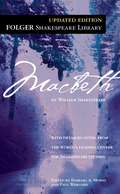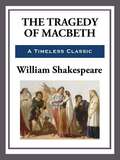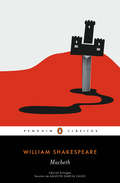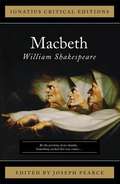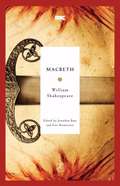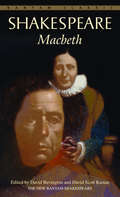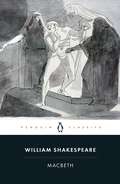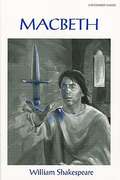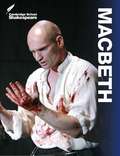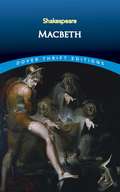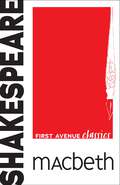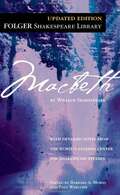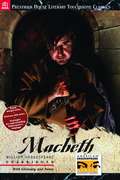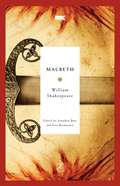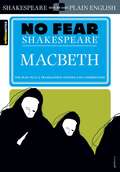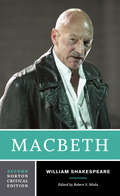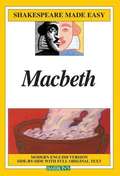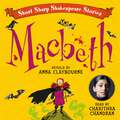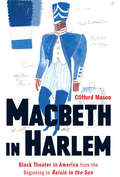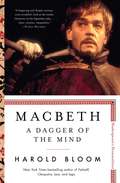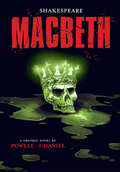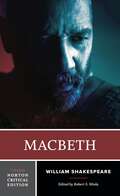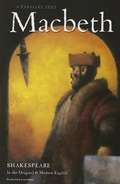- Table View
- List View
Macbeth
by William ShakespeareEach edition includes: Freshly edited text based on the best early printed version of the play Full explanatory notes conveniently placed on pages facing the text of the play Scene-by-scene plot summaries A key to famous lines and phrases An introduction to reading Shakespeare's language An essay by an outstanding scholar providing a modern perspective on the play Illustrations from the Folger Shakespeare Library's vast holdings of rare books Essay by Susan Snyder The Folger Shakespeare Library in Washington, D.C., is home to the world's largest collection of Shakespeare's printed works, and a magnet for Shakespeare scholars from around the globe. In addition to exhibitions open to the public throughout the year, the Folger offers a full calendar of performances and programs. For more information, visit www.folger.edu.
Macbeth
by William ShakespeareEach edition includes: Freshly edited text based on the best early printed version of the play Full explanatory notes conveniently placed on pages facing the text of the play Scene-by-scene plot summaries A key to famous lines and phrases An introduction to reading Shakespeare's language An essay by an outstanding scholar providing a modern perspective on the play Illustrations from the Folger Shakespeare Library's vast holdings of rare books Essay by Susan Snyder The Folger Shakespeare Library in Washington, D.C., is home to the world's largest collection of Shakespeare's printed works, and a magnet for Shakespeare scholars from around the globe. In addition to exhibitions open to the public throughout the year, the Folger offers a full calendar of performances and programs. For more information, visit www.folger.edu.
Macbeth
by William ShakespeareIntended for schools, these paperback editions include the complete and unabridged text of the play accompanied by notes giving explanations of difficult words or parts of the text.
Macbeth
by William ShakespeareArguably the darkest of all Shakespeare's plays, Macbeth is also one of the most challenging. Is it a work of nihilistic despair, "a tale told by an idiot, full of sound and fury, signifying nothing", or is it a cautionary tale warning of the dangers of Machiavellianism and relativism? Does it lead to hell and hopelessness, or does it point to a light beyond the darkness? This critical edition of Shakespeare's classic psychological drama contains essays by some of today's leading critics, exploring Macbeth as a morality play, as a history play with contemporary relevance, and as a drama that shows a vision of evil and that grapples with the problem of free will.
Macbeth
by William ShakespeareOne of Shakespeare’s most popular plays, filled with fierce, violent action, Macbeth is a human drama of ambition, desire, and guilt in a world of blood and darkness, with whispers of the supernatural.
Macbeth
by William ShakespeareNo dramatist has ever seen with more frightening clarity into the heart and mind of a murderer than has Shakespeare in this compelling tragedy of evil. Taunted into asserting his "masculinity" by his ambitious wife, Macbeth chooses to embrace the Weird Sisters' prophecy and kill his king-and thus, seals his own doom. Fast-moving and bloody, this drama has the extraordinary energy that derives from a brilliant plot replete with treachery and murder, and from Shakespeare's compelling portrait of the ultimate battle between a mind and its own guilt.Each Edition Includes:* Comprehensive explanatory notes * Vivid introductions and the most up-to-date scholarship * Clear, modernized spelling and punctuation, enabling contemporary readers to understand the Elizabethan English* Completely updated, detailed bibliographies and performance histories * An interpretive essay on film adaptations of the play, along with an extensive filmography. Notes and introduction provided by David Bevington and David Scott Kastan. [This text is listed as an example that meets Common Core Standards in English language arts in grades 9-10 at http://www.corestandards.org.]
Macbeth
by William Shakespeare'A supreme theatrical poem that has a language that eats into the soul' Michael Billington, GuardianShakeapeare's blood-soaked drama of murder, madness and the uncanny begins as Macbeth is promised a golden future as ruler of Scotland by supernatural forces. Spurred on by his wife, he murders the king to ensure his ambitions come true. But he soon learns the meaning of terror - killing once, he must kill again and again, while the dead return to haunt him. Macbeth is an anatomy of fear and a bleak portrayal of what some will do to achieve their desires.General Introduction by STANLEY WELLS Edited by GEORGE HUNTER Introduction by CAROL CHILLINGTON RUTTER
Macbeth (A Pacemaker Classic)
by William ShakespeareThis series inspires reading success and further exploration for all students. These classics are skillfully adapted into concise, softcover books.
Macbeth (Cambridge School Shakespeare Ser.)
by William Shakespeare Rex Gibson David James Richard Andrews Vicki Wienand Linzy BradyAn improved, larger-format edition of the Cambridge School Shakespeare plays, extensively rewritten, expanded and produced in an attractive new design. An active approach to classroom Shakespeare enables students to inhabit Shakespeare's imaginative world in accessible and creative ways. Students are encouraged to share Shakespeare's love of language, interest in character and sense of theatre. Substantially revised and extended in full colour, classroom activities are thematically organised in distinctive 'Stagecraft', 'Write about it', 'Language in the play', 'Characters' and 'Themes' features. Extended glossaries are aligned with the play text for easy reference. Expanded endnotes include extensive essay-writing guidance for 'Macbeth' and Shakespeare.
Macbeth (Dover Thrift Editions)
by William ShakespeareOne of the great Shakespearean tragedies, Macbeth is a dark and bloody drama of ambition, murder, guilt, and revenge. <P><P>Prompted by the prophecies of three mysterious witches and goaded by his ambitious wife, the Scottish thane Macbeth murders Duncan, King of Scotland, in order to succeed him on the throne. <P>This foul deed soon entangles the conscience-stricken nobleman in a web of treachery, deceit, and more murders, which ultimately spells his doom. <P>Set amid the gloomy castles and lonely heaths of medieval Scotland, Macbeth paints a striking dramatic portrait of a man of honor and integrity destroyed by a fatal character flaw and the tortures of a guilty imagination. <P>A selection of the Common Core State Standards Initiative.
Macbeth (First Avenue Classics ™)
by William ShakespeareTwo Scottish generals, Macbeth and Banquo, are on their way home from successful battles when they encounter three witches. With the prophecies of power and fame they give him swirling through his head, Macbeth tells his wife that the witches divined that he would become king of Scotland. Eager to see her husband as king, Lady Macbeth encourages him to murder King Duncan and assume the throne. A tale of obsession and forcing the fates, this unabridged version of William Shakespeare's classic English tragedy was first published in 1623.
Macbeth (Folger Shakespeare Library)
by William Shakespeare Barbara A. Mowat Paul WerstineNo dramatist has ever seen with more frightening clarity into the heart and mind of a murderer than has Shakespeare in this compelling tragedy of evil. Taunted into asserting his "masculinity" by his ambitious wife, Macbeth chooses to embrace the Weird Sisters' prophecy and kill his kingand thus, seals his own doom. Fast-moving and bloody, this drama has the extraordinary energy that derives from a brilliant plot replete with treachery and murder, and from Shakespeare's compelling portrait of the ultimate battle between a mind and its own guilt. Each Edition Includes: Comprehensive explanatory notes Vivid introductions and the most up-to-date scholarship Clear, modernized spelling and punctuation, enabling contemporary readers to understand the Elizabethan English Completely updated, detailed bibliographies and performance histories An interpretive essay on film adaptations of the play, along with an extensive filmography From the Paperback edition.
Macbeth (Literary Touchstone Classics)
by William ShakespeareShakespeare's Macbeth is an intense examination of the corrupting nature of power, the ability of humans to choose their own destinies, and the lengths to which people will go to satisfy their own desires. The book includes a glossary of the more difficult words, as well as convenient sidebar notes to enlighten the reader on aspects that may be confusing or overlooked.
Macbeth (Modern Library Classics)
by William ShakespeareNo dramatist has ever seen with more frightening clarity into the heart and mind of a murderer than has Shakespeare in this compelling tragedy of evil. Taunted into asserting his “masculinity” by his ambitious wife, Macbeth chooses to embrace the Weird Sisters’ prophecy and kill his king–and thus, seals his own doom. Fast-moving and bloody, this drama has the extraordinary energy that derives from a brilliant plot replete with treachery and murder, and from Shakespeare’s compelling portrait of the ultimate battle between a mind and its own guilt. [This text is listed as an example that meets Common Core Standards in English language arts in grades 9-10 at http://www.corestandards.org.]
Macbeth (No Fear Shakespeare)
by William ShakespeareNo Fear Shakespeare gives you the complete text of Macbeth on the left-hand page, side-by-side with an easy-to-understand translation on the right. <p><p> Each No Fear Shakespeare contains <p> • The complete text of the original play <p> • A line-by-line translation that puts Shakespeare into everyday language <p> • A complete list of characters with descriptions <p> • Plenty of helpful commentary
Macbeth (Second Edition) (Norton Critical Editions)
by William Shakespeare Robert S. MiolaA tragedy that evokes both pity and terror—now in a thoroughly revised and updated Norton Critical Edition. The Norton Critical Edition is again based on the First Folio (1623), the only authoritative text of the play. The volume includes a revised introduction and new annotations and textual notes. The Second Edition also includes the innovative feature “The Actors’ Gallery,” which presents famous actors and actresses—among them David Garrick, Sarah Siddons, Ian McKellen, Hira Mikijirô, Patrick Stewart, and Kate Fleetwood—reflecting on their roles in major productions of Macbeth for stage and screen. “Sources and Contexts” provides readers with an understanding of Macbeth’s origins in earlier texts, specifically the works of the Roman playwright Seneca, the Tudor historian Raphael Holinshed, and the medieval drama The Slaughter of the Innocents and the Death of Herod. Contexts for the play include contemporary debates on predestination versus free will (Martin Luther versus Erasmus), witchcraft as fiction or fact (Reginald Scott versus King James I), the ethics of regicide (an Elizabethan homily versus Jan de Mariana, S.J.), and the ethics of equivocation (Henry Garnet, S.J., versus—new to the Second Edition—Sir Edward Coke). Eight carefully chosen essays represent four hundred years of critical and theatrical interpretation. Contributors include Simon Forman, Samuel Johnson, Samuel Taylor Coleridge, Thomas De Quincey, Harry Levin, Stephen Orgel, Peter Holland, and, presenting the latest arguments on the authorship controversy, Gary Taylor. Finally, an engaging new selection of Macbeth’s “Afterlives” includes excerpts from Giuseppi Verdi’s Macbeth and related letters, Eugene Ionesco’s Macbett (1972), Bill Cain’s Equivocation (2009), and more. This edition also provides a list of online and print resources.
Macbeth (Shakespeare Made Easy)
by William Shakespeare Alan DurbandHere are the books that help teach Shakespeare plays without the teacher constantly needing to explain and define Elizabethan terms, slang, and other ways of expression that are different from our own. Each play is presented with Shakespeare's original lines on each left-hand page, and a modern, easy-to-understand "translation" on the facing right-hand page. All dramas are complete, with every original Shakespearian line, and a full-length modern rendition of the text.
Macbeth (Short, Sharp Shakespeare Stories #25)
by Anna ClaybourneIs this a dagger which I see before me...?A power-hungry general, his crazed wife, three interfering witches and some terrifying ghosts... Listen on, through murder and mayhem, to discover the gripping story of Macbeth, one of Shakespeare's most famous tragedies.As well as the story, this audiobook contains information about the background to Macbeth, its major themes, language, and Shakespeare's life during the time he was writing the play. Witches and witchcraft in 16th century England are also examined, to give the context in which the play was written. The Short, Sharp Shakespeare series consists of six books that retell Shakespeare's most famous plays in modern English. Fun sound effects and atmospheric music accompany each narration, making them a great introduction to "the Bard" for children.(P) 2023 Hodder & Stoughton Limited
Macbeth in Harlem: Black Theater in America from the Beginning to Raisin in the Sun
by Clifford MasonIn 1936 Orson Welles directed a celebrated all-black production of Macbeth that was hailed as a breakthrough for African Americans in the theater. For over a century, black performers had fought for the right to perform on the American stage, going all the way back to an 1820s Shakespearean troupe that performed Richard III, Othello, and Macbeth, without relying on white patronage. "Macbeth" in Harlem tells the story of these actors and their fellow black theatrical artists, from the early nineteenth century to the dawn of the civil rights era. For the first time we see how African American performers fought to carve out a space for authentic black voices onstage, at a time when blockbuster plays like Uncle Tom’s Cabin and The Octoroon trafficked in cheap stereotypes. Though the Harlem Renaissance brought an influx of talented black writers and directors to the forefront of the American stage, they still struggled to gain recognition from an indifferent critical press. Above all, "Macbeth" in Harlem is a testament to black artistry thriving in the face of adversity. It chronicles how even as the endemic racism in American society and its theatrical establishment forced black performers to abase themselves for white audiences’ amusement, African Americans overcame those obstacles to enrich the nation’s theater in countless ways.
Macbeth, and King Richard The Third: An Essay, In Answer to Remarks on Some of The Characters of Shakespeare (Routledge Revivals)
by J.P. KembleJohn Philip Kemble was an ambitious and successful stage actor in London, perhaps most well-known for his turn as Shakespeare’s Macbeth. Kemble passionately disagreed with the posthumous work of Thomas Watley, Remarks on Some of the Characters of Shakespeare (1785), particularly Watley’s representations of some of Shakespeare’s greatest villains, Richard III and Macbeth. This title, first published in 1786 (this reprint of the second edition first published in 1970), presents Kemble’s nuanced criticisms of the characters leaving the impression that the villainies of Macbeth and Richard III are indeed similar. A historically important literary reaction, this title will be of interest to students of English literature and literary criticism.
Macbeth: A Dagger of the Mind (Shakespeare's Personalities #5)
by Harold BloomFrom the greatest Shakespeare scholar of our time, comes a portrait of Macbeth, one of William Shakespeare’s most complex and compelling anti-heroes—the final volume in a series of five short books about the great playwright’s most significant personalities: Falstaff, Cleopatra, Lear, Iago, Macbeth.From the ambitious and mad titular character to his devilish wife Lady Macbeth to the moral and noble Banquo to the mysterious Three Witches, Macbeth is one of William Shakespeare’s more brilliantly populated plays and remains among the most widely read, performed in innovative productions set in a vast array of times and locations, from Nazi Germany to Revolutionary Cuba. Macbeth is a distinguished warrior hero, who over the course of the play, transforms into a brutal, murderous villain and pays an extraordinary price for committing an evil act. A man consumed with ambition and self-doubt, Macbeth is one of Shakespeare’s most vital meditations on the dangerous corners of the human imagination. Award-winning writer and beloved professor Harold Bloom investigates Macbeth’s interiority and unthinkable actions with razor-sharp insight, agility, and compassion. He also explores his own personal relationship to the character: Just as we encounter one Anna Karenina or Jay Gatsby when we are seventeen and another when we are forty, Bloom writes about his shifting understanding—over the course of his own lifetime—of this endlessly compelling figure, so that the book also becomes an extraordinarily moving argument for literature as a path to and a measure of our humanity. Bloom is mesmerizing in the classroom, wrestling with the often tragic choices Shakespeare’s characters make. He delivers that kind of exhilarating intimacy and clarity in Macbeth, the final book in an essential series.
Macbeth: A Graphic Novel
by William Shakespeare Martin PowellThe epic tale of Macbeth retold in graphic-novel format. Macbeth and Banquo are Scottish generals returning home from a victorious war campaign. Their journey is interrupted when three strange witches come upon them and predict their futures. They claim that Macbeth will one day become King of Scotland! Macbeth is stirred by the prophesy. With the help of his scheming wife, he sets into motion a sinister plan that will paint bloody strokes across the entire landscape of Scotland.
Macbeth: A Graphic Novel
by William Shakespeare Martin PowellThe epic tale of Macbeth retold in graphic-novel format. Macbeth and Banquo are Scottish generals returning home from a victorious war campaign. Their journey is interrupted when three strange witches come upon them and predict their futures. They claim that Macbeth will one day become King of Scotland! Macbeth is stirred by the prophesy. With the help of his scheming wife, he sets into motion a sinister plan that will paint bloody strokes across the entire landscape of Scotland.
Macbeth: A Norton Critical Edition (Norton Critical Editions)
by William Shakespeare“With clear and engaging explanation, Professor Miola offers a general introduction to the play, as well as commentary from well-known actors who have played its major roles from the mid-eighteenth century on and material on critical debates. Rather than take single viewpoints on such topics as witchcraft, tyrannicide, equivocation, and the union of Scotland and England, he presents each issue as a debate, open to fruitful discussion among students and colleagues.”—CYNTHIA LEWIS, Davidson College “Framing this devastating play with illuminating readings, this wonderful edition offers readers a vivid introduction to the Macbeths’ blood-steeped world.”—TANYA POLLARD, City University of New York University This Norton Critical Edition includes: The First Folio (1623) text of Macbeth, with updated and expanded footnotes and introductory materials by Robert S. Miola. Illustrations from a wide range of adaptations, including modern stage and film productions. “The Actors’ Gallery,” collecting reflections from actors and actresses about their roles in major productions of Macbeth from the eighteenth to twenty-first centuries. Sources and contexts highlighting early texts that influenced Shakespeare and that range in topics from witchcraft to regicide, with a brand-new category on the union of Scotland and England. Nine selections—four new to the Third Edition—of literary and theatrical criticism. A revised “Afterlives” section, featuring four examples of how Macbeth continues to be reimagined beyond the Folio. An annotated list of online and print resources.
Macbeth: A Parallel Text (The Shakespeare Parallel Text Series)
by William ShakespeareIn its concentration of interest upon the protagonists, Macbeth can be seen as Shakespeare's experiment in unity of focus, whose chief appeal arises from the struggles of the central characters with each other and with the infernal powers that inspire or govern them. <P><P> Over the centuries, the vision of directors like Welles, Nunn and Polanski, as well as the eloquent talents of actors like Garrick, Siddons, Olivier and McKellen have contributed to the central debate of the play: Who or what is culpable? <P><P> Bernice W. Kliman, in her analysis of Macbeth in performance, examines major productions of the play on both stage and screen, thereby inviting the reader to contemplate directors' and actors' choices for what is arguably Shakespeare's most compelling play.
